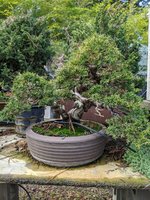MaciekA
Shohin
I hadn't heard this before. Do you have a place I can read more about this? Upon searching this in Google, the only place I see this mentioned is kn here by you, so I'm curious to find if this is informed by experience or something else.
I am considering doing an earlier prune as soon as... well, whenever I get the chance and then saving wiring for the workshop.
Junipers don't store all of their energy in the foliage. They just store more of it in their foliage than many other conifers -- these are very plump and substantially massive leaves for a conifer after all. There's still plenty of starch in the limbs and roots like anything else. I don't have an academic paper for you to read, but it's one of the most oft-repeated quasi-facts in the Bonsai Mirai universe, and other professionals do not disagree. It also would explain why juniper cuttings take root so easily.



